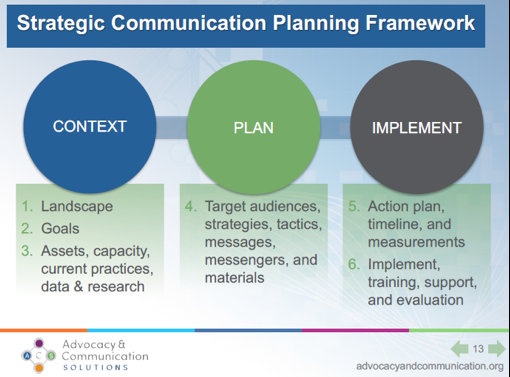 Often planning how to communicate results is an afterthought, but early consideration of communicating the vision, mission, action, and progress throughout all phases of the cycle is vital to the success of an initiative. For every step along the way, from creating awareness and enlisting interested parties to publicizing progress and maintaining momentum, leadership should develop a communication plan and strategies. When significant issues are addressed and much is at stake, collective leadership requires a disciplined, strategic approach to communication to ensure its message is conveyed and heard as intended.
Often planning how to communicate results is an afterthought, but early consideration of communicating the vision, mission, action, and progress throughout all phases of the cycle is vital to the success of an initiative. For every step along the way, from creating awareness and enlisting interested parties to publicizing progress and maintaining momentum, leadership should develop a communication plan and strategies. When significant issues are addressed and much is at stake, collective leadership requires a disciplined, strategic approach to communication to ensure its message is conveyed and heard as intended.
Early education leaders have an individual and collective responsibility to provide accurate, timely, and tailored information to keep others informed and engaged, whether it be internally for their superintendent, director, or staff, or externally for cross-agency partners, legislators, governor, or the general public. SEAs and LEAs may have designated communications specialists or offices, so it becomes the responsibility of the early education leader to serve as the content expert and being proactive in keeping others informed of things as they develop or in advance.
What is involved in effective communication? It is essential for engaged stakeholders to think strategically about communications from the beginning and integrate it throughout the life of the project. Leadership should know the purpose, audience, message, messengers, and methods involved in the group’s communications, all of which are incorporated into a Communications Plan. Developing a shared strategic communication plan considers several steps in three key areas – Context, Plan, Implement (ACS, 2017).

The leadership group should enlist knowledgeable communications stakeholders to lend their expertise as early as possible, considering steps to coordinate information internally and externally. These stakeholders can provide valuable support to early education in getting their messages across, including multiple methods including press releases, news features, editorials, public service announcements, press conferences, newsletters, fact sheets, and email lists. Many SEAs and LEAs also report results on “data dashboards” found on their websites.
Communications specialists also offer valuable advice for early education leaders in telling their story and highlighting achievements. For example, Advocacy and Communication Solutions provided useful tips to CEELO Leadership Academy Fellows, including suggestions for framing, pivoting, and storytelling.
Despite every effort to communicate achievements proactively and positively, unintended issues and unforeseen crises may arise. Long-range goals may be derailed unnecessarily by ineffective communication. A strategic communications plan can help defuse potentially damaging situations by handling a crisis successfully, allowing important work to continue.
Resources
- Communications to Promote Interest (Center for Community Health and Development at the University of Kansas, 2016)
- CEELO Leadership Academy Communications Training Materials (ACS, 2017)
- Benefits of Communicating and Engaging With Stakeholders (Child Care State Capacity Building Center, N.D.)
- Stakeholder Communications Guide (Child Care State Capacity Building Center, 2016)
- Media Matters: The Complete Guide to Getting Positive Media Attention (ACS, 2015)
- Guide to Results-Based Planning and Facilitation: Achieving Results and Equity for Vulnerable Children and Youth (National Results and Equity Collaborative, 2014, p. 27)
Activities
- Giving Jargon the Boot (ACS, 2017)
- Message Creation Checklist (ACS, 2016)
